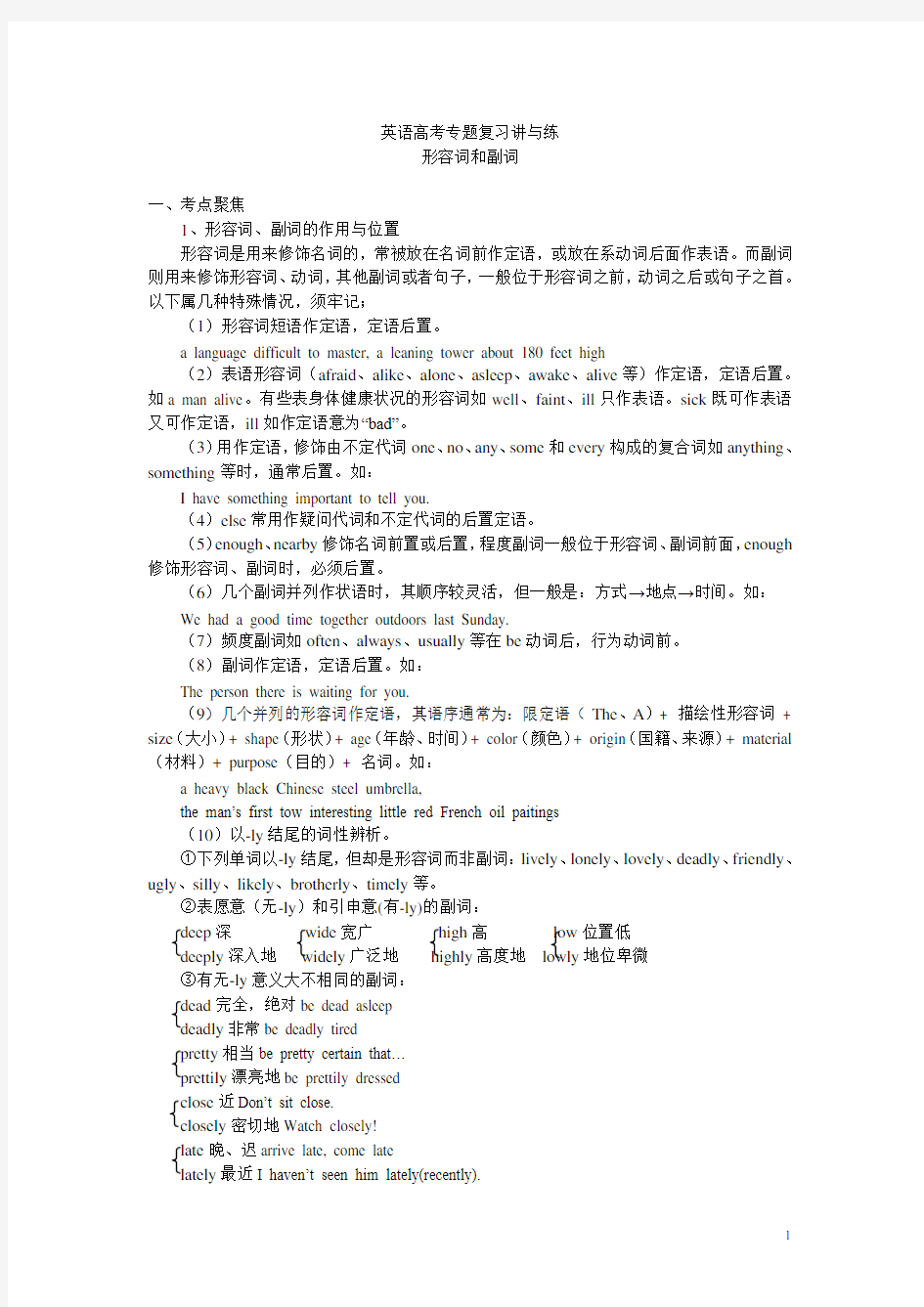
(完整)高考英语形容词和副词详解及练习
- 格式:doc
- 大小:110.02 KB
- 文档页数:13


英语高考专题复习讲与练
形容词和副词
一、考点聚焦
1、形容词、副词的作用与位置
形容词是用来修饰名词的,常被放在名词前作定语,或放在系动词后面作表语。而副词则用来修饰形容词、动词,其他副词或者句子,一般位于形容词之前,动词之后或句子之首。以下属几种特殊情况,须牢记;
(1)形容词短语作定语,定语后置。
a language difficult to master, a leaning tower about 180 feet high
(2)表语形容词(afraid、alike、alone、asleep、awake、alive等)作定语,定语后置。如a man alive。有些表身体健康状况的形容词如well、faint、ill只作表语。sick既可作表语又可作定语,ill如作定语意为“bad”。
(3)用作定语,修饰由不定代词one、no、any、some和every构成的复合词如anything、something等时,通常后置。如:
I have something important to tell you.
(4)else常用作疑问代词和不定代词的后置定语。
(5)enough、nearby修饰名词前置或后置,程度副词一般位于形容词、副词前面,enough 修饰形容词、副词时,必须后置。
(6)几个副词并列作状语时,其顺序较灵活,但一般是:方式→地点→时间。如:We had a good time together outdoors last Sunday.
(7)频度副词如often、always、usually等在be动词后,行为动词前。
(8)副词作定语,定语后置。如:
The person there is waiting for you.
(9)几个并列的形容词作定语,其语序通常为:限定语(The、A)+ 描绘性形容词+ size(大小)+ shape(形状)+ age(年龄、时间)+ color(颜色)+ origin(国籍、来源)+ material (材料)+ purpose(目的)+ 名词。如:
a heavy black Chinese steel umbrella,
the man’s first tow interesting little red French oil paitings
(10)以-ly结尾的词性辨析。
①下列单词以-ly结尾,但却是形容词而非副词:lively、lonely、lovely、deadly、friendly、ugly、silly、likely、brotherly、timely等。
②表愿意(无-ly)和引申意(有-ly)的副词:
deep深wide宽广high高low位置低
deeply深入地widely广泛地highly高度地lowly地位卑微
③有无-ly意义大不相同的副词:
dead完全,绝对be dead asleep
deadly非常be deadly tired
pretty相当be pretty certain that…
prettily漂亮地be prettily dressed
close近Don’t sit close.
closely密切地Watch closely!
late晚、迟arrive late, come late
lately最近I haven’t seen him lately(recently).
2、复合形容词的构成
(1)形容词+ 名词+ ed
kind-hearted好心的,white-haired白发的
(2)形容词+ 形容词
red-hot炽热的,dark-blue深蓝的
(3)形容词+ 现在分词
good-looking好看的,easy-going随和的
(4)副词+ 现在分词
hard-working勤劳的,fast-moving快速转动的
(5)副词+ 过去分词
hard-won得来不易的,newly-made新建的
(6)名词+ 形容词
life-long终生的,world-famous世界闻名的
(7)名词+ 现在分词
peace-loving爱好和平的,fun-loving爱开玩笑的
(8)名词+ 过去分词
snow-covered白雪覆盖的,hand-made手工的
(9)数词+ 名词+ ed
four-storeyed 4层楼的,three-legged 3条腿的
(10)数词+ 名词(名词用单数)
ten-year 10年的,two-man两人的
3、形容词和副词的比较等级
(1)原级的构成和用法。
构成:形容词、副词的原级即本身。
用法:表示双方在程度、性质、特征等某方面相等时,用“as + 原级形容词/副词+ as”的结构;表示双方不相等时,用“not so(as) + 原级形容词/副词+ as”的结构;表示一方是另一方的若干倍时,用“倍数+ as + 原级形容词/副词+ as”的结构。如:
Xiao Wang is as tall as Xiao Yu.
This building looks not so (as)high as that one.
Miss Xu speaks English as fluently as you .
This room is three times as large as that one.
(2)比较级和最高级的构成。
掌握比较级和最高级的变化规则,熟记少数不符合规则的特殊形容词和副词。
(3)比较级的用法。
①对方比较,表示一方超过另一方时,用“比较级+ than”的结构表示。如:
This picture is more beautiful than that one.
②表示一方不及另一方时,用“less + 原级+ than”的结构表示。如:
This room is less beautiful than that one.
③表示一方超过另一方的程度或数量时,可在比较级前加表示程度的状语,如even、a lot、a bit、a little、still、much、far、yet、by far等修饰。如:
He works even harder than before.
He found he got 2cm higher than one year before when he measured himself yesterday. Mary kept weighing herself to see how much ___ she was getting.
A. heavier
B. heavy
C. the heavier
D. the heaviest